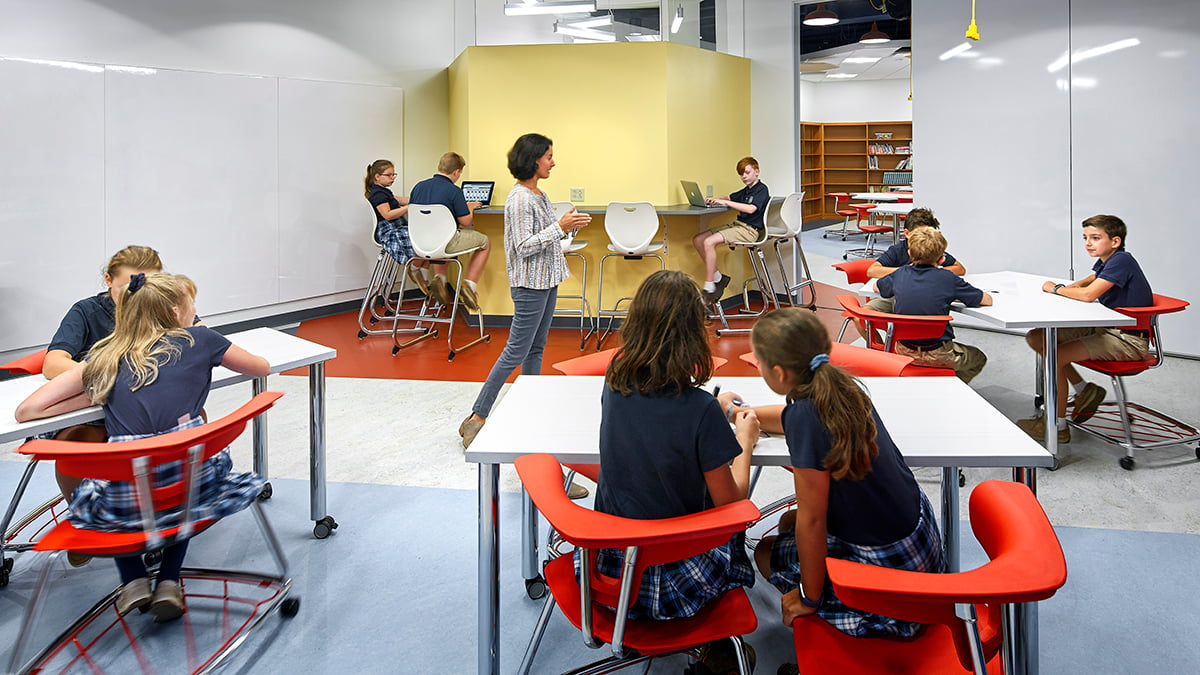Learn how empowering students and teachers to shape their classroom environments leads to more personalized, adaptable, and effective learning spaces.
Throughout history, classroom design has often been driven by educational trends, technological advances, and evolving philosophies on teaching and learning. From the traditional rows of desks in the early 20th century to the collaborative, adaptable spaces of today, the design of learning environments has continued to evolve.
Yet, one aspect is often overlooked: listening to the voices of the students and teachers who use these spaces every day.
After serving more than two decades as both a teacher and a principal (and supporting our first and second classroom furniture giveaways!), I’ve witnessed the incredible impact of giving students and teachers a voice in shaping their learning environments.
When these stakeholders are given voice and choice over their classroom space, the change is meaningful and the impact on learning is powerful. In the following insights, I'm excited to share how education administrators can facilitate input from students and teachers to reveal invaluable insights that will transform classrooms into more engaging and adaptable environments.
Increased Motivation and Engagement
The more students are involved in shaping their learning experiences, the more motivated and engaged they become.
This can take many forms, from selecting projects they’re passionate about to choosing where they sit in the classroom. These small choices lead to greater investment both in their work and the learning process. When students feel valued and involved, they are more likely to participate actively.
Teachers benefit from this empowerment as well. By having a say in how their classroom is organized and designed, teachers can create spaces that align with their goals and resonate more effectively with their teaching styles.
This creates a ripple effect: motivated students lead to more fulfilled teachers.
Cultivating a Sense of Belonging
Classroom design that reflects the preferences and needs of its occupants fosters a sense of community. For students, providing varied seating options and learning zones empowers students to choose spaces where they feel comfortable and ready to learn. When they feel physically relaxed, their emotional and cognitive engagement rises, leading to better participation and academic success.
Similarly, a space that allows teachers to work creatively, move freely, and connect with students in varied settings, reinforces their role as leaders and collaborators. Involving them in the design ensures that classrooms are functional and nurturing for everyone.
Positive Impact on Learning Outcomes
Research from both the University of California–Riverside and Northwestern University shows that when students are given a voice in their learning, academic performance improves.
Choices and flexibility in how they demonstrate their understanding—whether through writing, videos, presentations, or artistic methods—allows them to highlight their strengths and reinforces their grasp of the material. A teacher doesn’t want to grade 25 of the same activity. Having a voice and variety in the work makes for a more creative and dynamic learning environment.
Critical Thinking and Real-World Skills Development
Giving students the opportunity to make decisions—whether it’s in the arrangement of the classroom or their learning projects—helps develop essential life skills such as critical thinking, decision-making, and self-advocacy. Students learn early on how to express their ideas, negotiate with their peers, and problem-solve, preparing them for future challenges.
In addition, teachers gain a clearer understanding of student thought processes and can offer tailored support for each student. By fostering an open environment, students feel safe to express their opinions, allowing teachers to extend learning beyond the basics of the curriculum and into critical reflection and debate.
Strengthening Teacher-Student Relationships
Classrooms designed with input from both teachers and students create spaces where relationships can flourish. Open communication between teachers and students builds mutual respect and trust, which are foundational to a positive learning environment. When students feel like their opinions matter, they’re more likely to engage with the material and be proactive in their learning.
Likewise, teachers benefit from understanding their students better, which helps in building a classroom community centered around collaboration and respect.
Practical Approaches to Incorporating Voice and Choice in Classroom Design
Giving students and teachers a voice in shaping their learning environments goes beyond classroom design.
Here are a few key strategies I’ve found effective throughout my career:
- Student-Led Conferences: Empower students to take charge of their learning by leading parent-teacher conferences. This promotes reflection, accountability, and goal setting.
- Feedback Loops: Establish regular feedback sessions where students can offer suggestions, ensuring their voices are heard and implemented.
- Choice Boards and Flexible Seating: Offer choice boards and varied seating options to give students autonomy over their learning and physical space.
- Project-Based Learning (PBL): Encourage students to explore topics they’re passionate about, deepening engagement and creativity.
- Collaborative Spaces and Teacher Mobility: Classrooms with flexible furniture, round tables, and open spaces foster better communication and interaction.
Designing with Input
Incorporating choice into the physical setup of a classroom fosters a sense of ownership and engagement and provides a profound impact on learning and the environment.
In my experience, creating a partnership where students and teachers actively shape their spaces leads to deeper learning and more meaningful interactions. For example, allowing students and teachers to select furniture that can be easily rearranged supports different teaching methods and learning activities. Teachers and students can quickly adapt the space for group work, individual study, or whole-class discussions, fostering a dynamic and responsive learning environment.
Designing areas specifically for collaboration such as round tables or group workstations encourages students to work together and share ideas. This setup promotes student voice by making it easier for them to communicate and collaborate.
Reducing the number of fixed items in the classroom allows teachers to move around more freely, facilitating better interaction with students. This helps teachers be more responsive to student needs and create a more inclusive atmosphere.
The Power of Collaborative Classroom Design
Students are more likely to engage in a well-designed space—including considerations for furniture, lighting, and acoustics—that feels inviting and conducive to learning.
By actively involving students and teachers in classroom design, you can create environments that not only meet the functional needs of your education spaces but also foster creativity, engagement, and a sense of community. These approaches prepare students and teachers for success, equipping them with the skills, confidence, and environment to thrive in an ever-evolving educational landscape.
I share more about how to shape a learning environment that elevates student experiences in a recent EDchat. I promise it's worth your time to listen! Check it out here.















